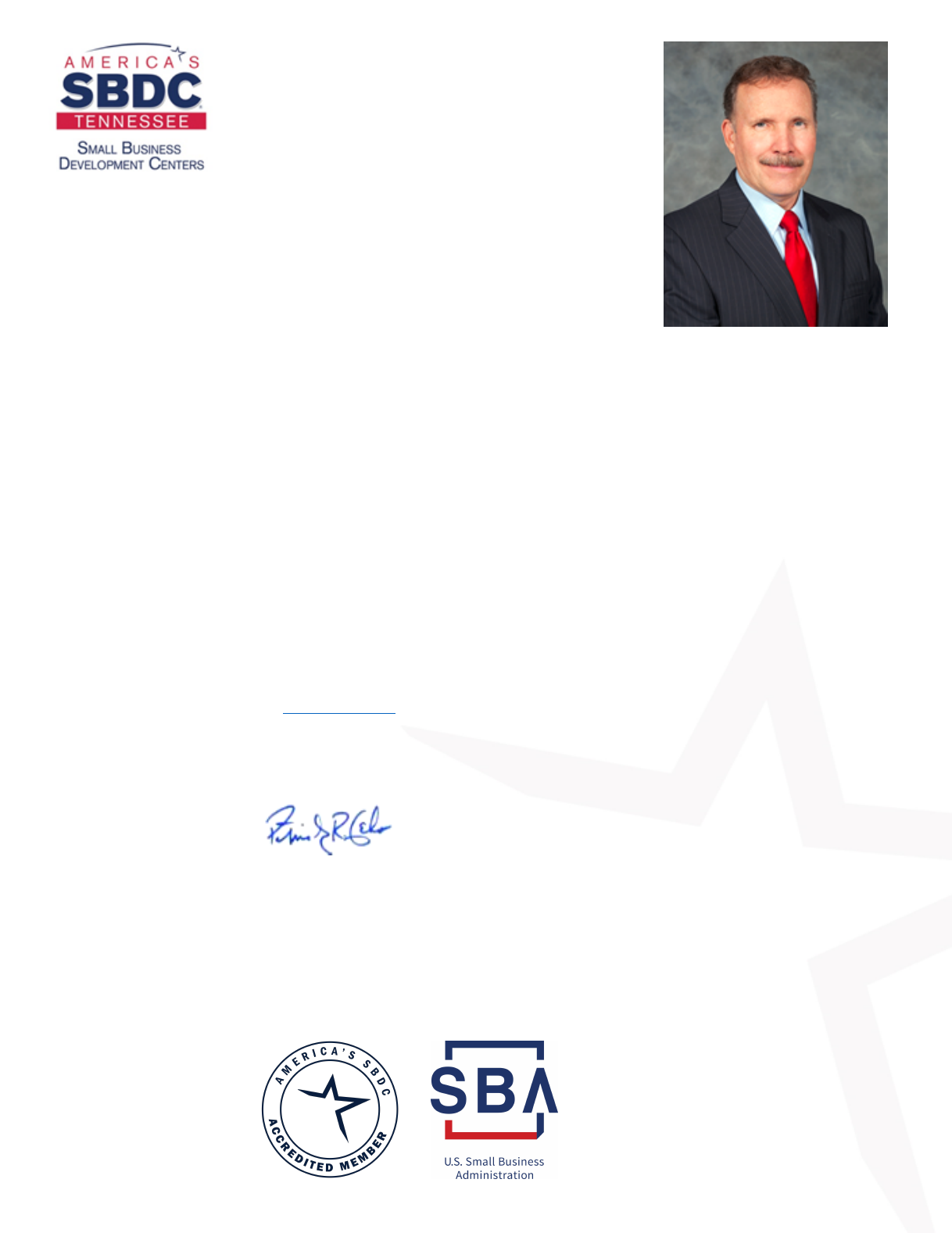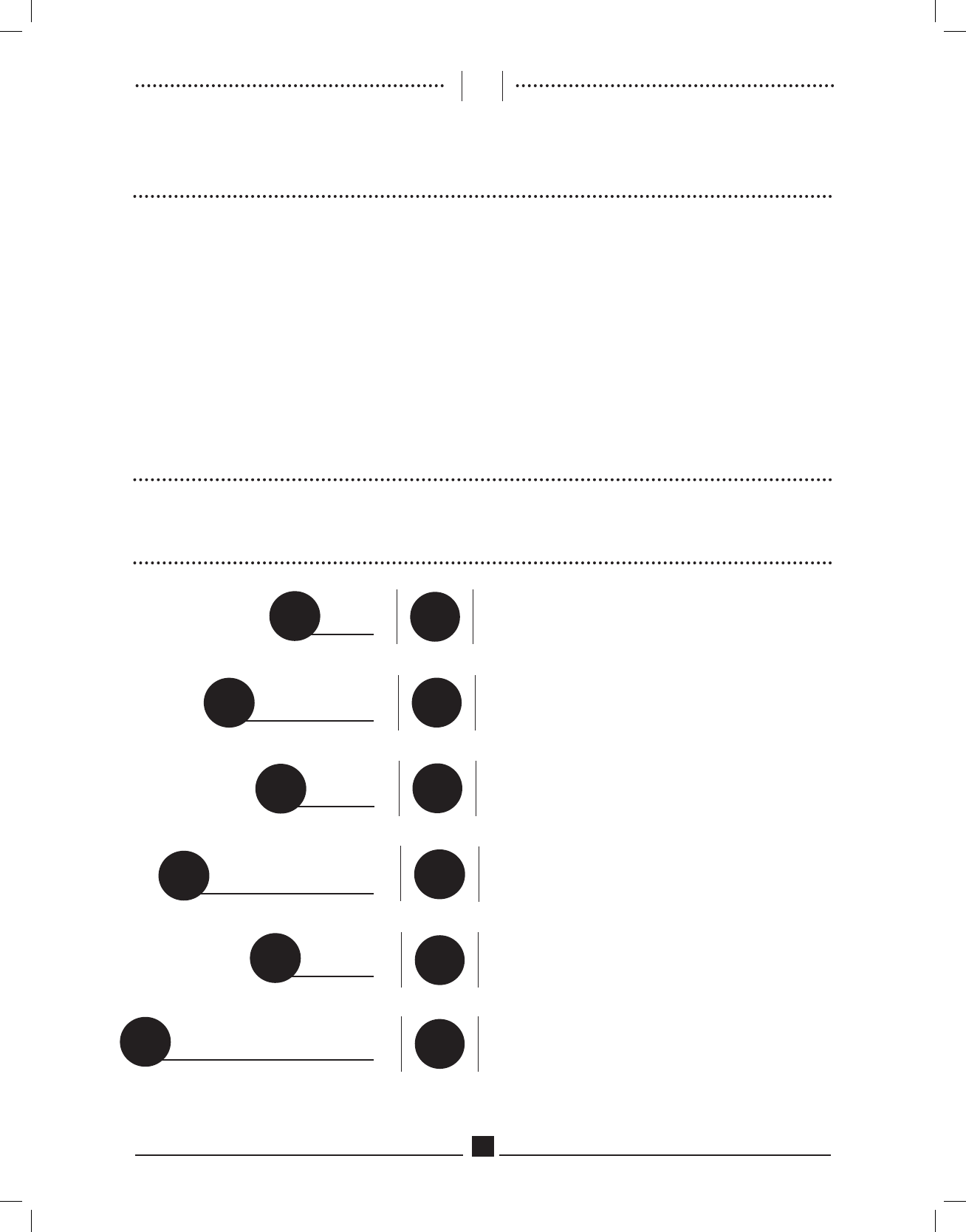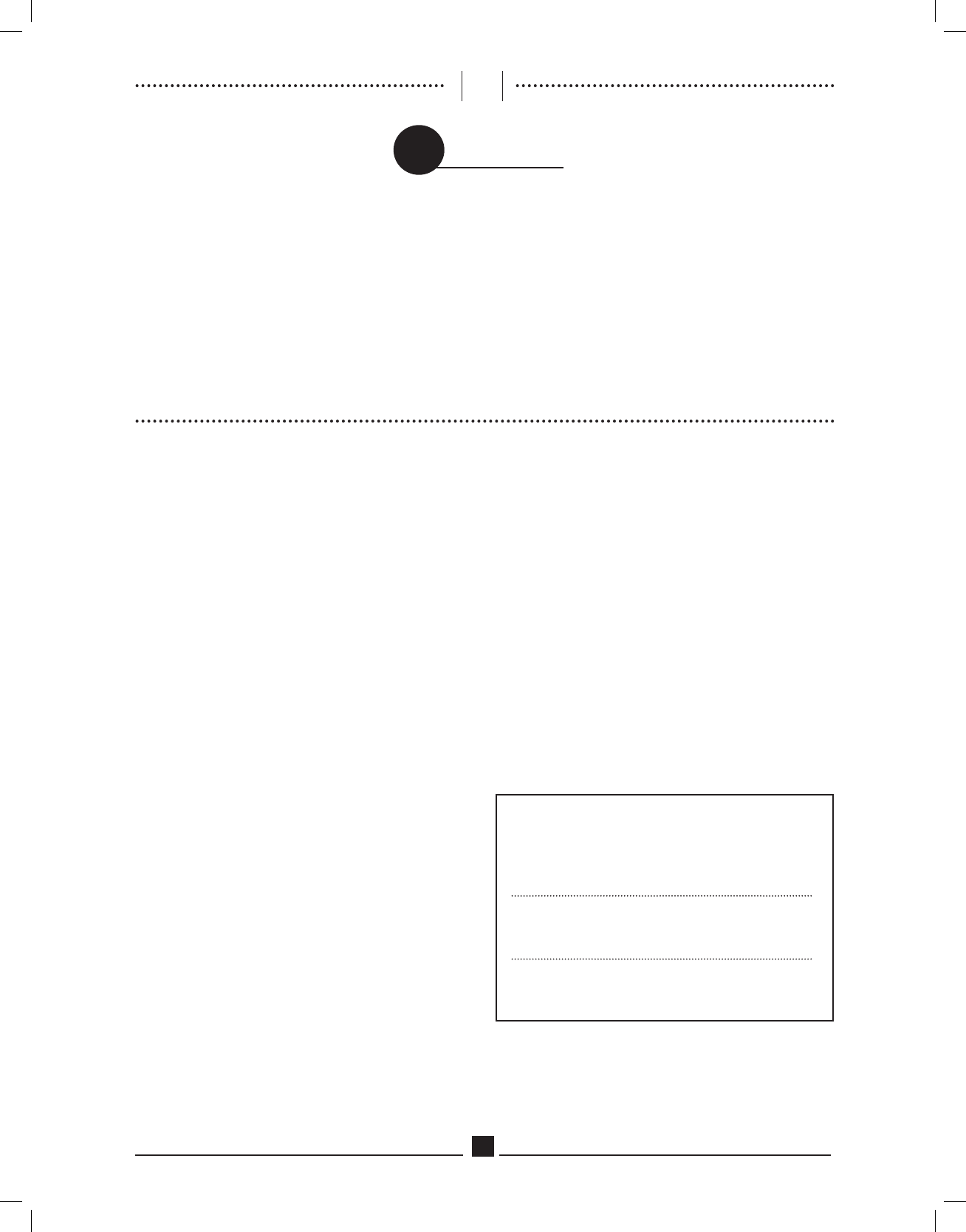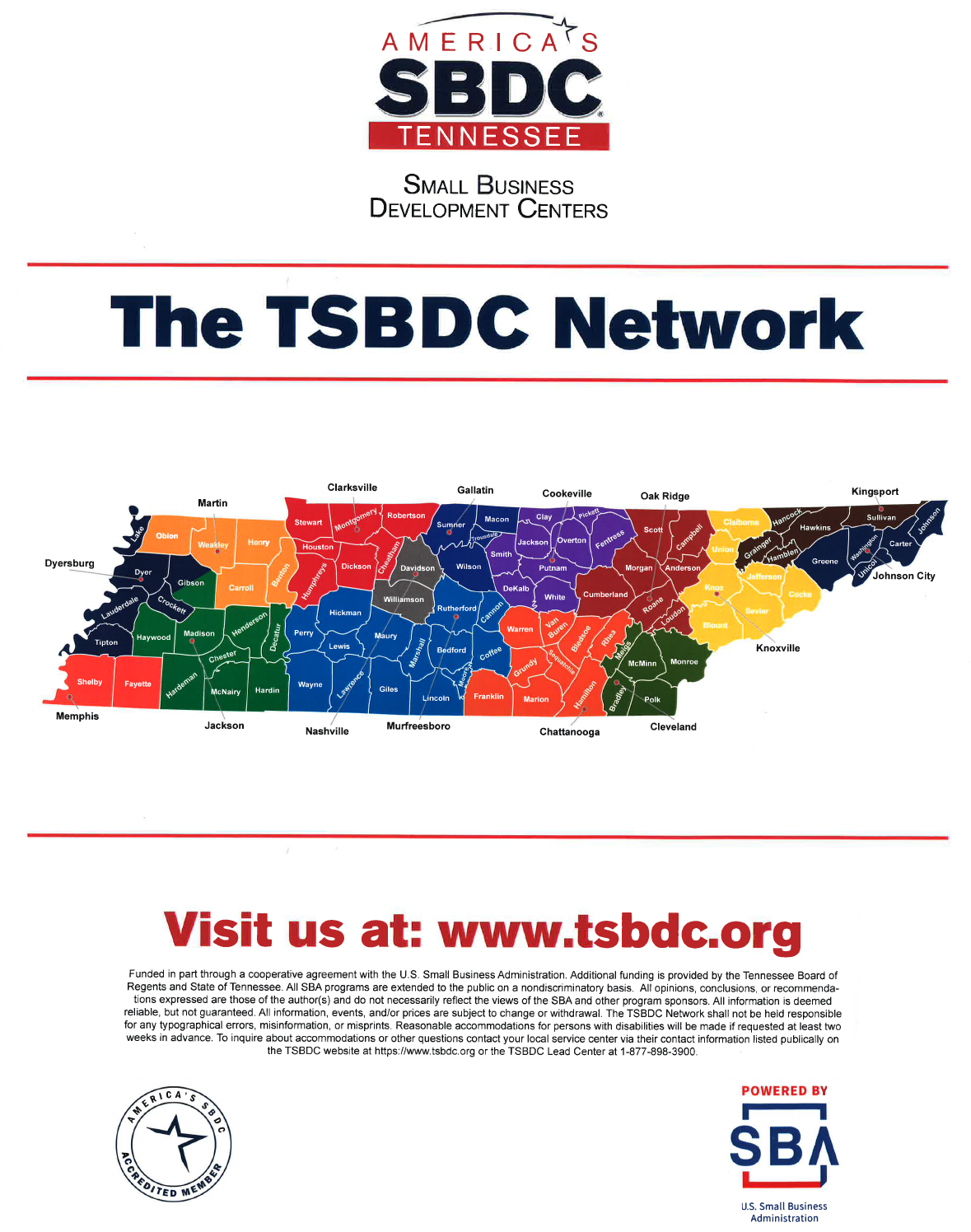
A Simple Guide To Your
Small Business
MARKETING PLAN
YOUR PLACE IN THE
MARKETPLACE
Tennessee Small Business Development Center Network Lead Center
Toll Free:Phone:Fax:
Small Business
Development Centers

Upper
Cumberland
Development District

3
3
GOT A GOOD PRODUCT? A GREAT SERVICE?
UNFORTUNATELY, THAT’S NOT ENOUGH.
Smart, targeted, relentless marketing is often the
difference between a business that has reached
a plateau and one that has reached its potential.
Savvy entrepreneurs who respect the power
of marketing think of it as an investment rather
than an expense, and devote money, time and
energy to their marketing goals.
In simple, easy-to-understand language, this book
aims to empower business owners to market
smarter, using both digital and traditional meth-
ods. It’s a basic framework for “selling” your
company to today’s educated, savvy consumers
in a crowded, dynamic marketplace.
Whether you’re a retailer or a manufacturer,
whether you sell a product or service, whether
you operate from a storefront or a mobile
platform, whether your audience is local or
global – there are overreaching principles that
apply to every circumstance.
In a world is spinning faster than ever – pro-
pelled by industry trends, consumer sentiment
and the economy – think of your business as a
video rather than a photo. Start with a plan, but
don’t be reluctant to tweak it! Smart marketers
remain nimble in order to remain vital.
HERE’S WHAT’S INSIDE
The 6 Ps are the building blocks of a solid marketing foundation.
How will you create awareness? Can
effective marketing be exciting, too?
8
PAGE
P
romotion
Without one, your efforts will be scattered
and your results not measurable.
4
PAGE
P
lan
Is there a demand? How will you
differentiate yourself from the crowd?
5
PAGE
P
roduct
How much is too much?
Are sales high, but profits low?
7
PAGE
P
rice
P
lace
How will you connect your product
or service with your customers?
14
PAGE
P
erformance
Measuring the effectiveness of your marketing
may be challenging. But it’s invaluable.
15
PAGE
Design and Text: ©NewGround Publications. (Telephone: 800 207-3550).
All rights reserved. Photocopying any part of this book is against the law. This book may not be reproduced in any form, including xerography, or by any electronic
or mechanical means, including information storage and retrieval systems, without prior permission in writing from the publisher. 0420

4
4
PLAN
MARKETING YOUR SMALL BUSINESS MAY SEEM LIKE
A DAUNTING TASK, BUT LIKE ALL TASKS,
THE FIRST STEP IS TO FORMULATE A PLAN.
Remember that lenders look closely at your marketing plan in relation to
your financial statements. Designate a specific amount of money in the yearly
budget for marketing. Keep in mind that new businesses often require more
marketing dollars to establish themselves than established companies.
Finding Your Customer
You must think constantly about who your customers
are. In what ways will they use your product or
service? How often will they buy? Think about their
age, income, gender, education, marital status,
profession, lifestyle, hobbies and household size.
In short, put yourself in their place.
If you’re targeting businesses, the good news is that
there’s extensive data readily available, to better
understand their size, annual sales, number of
employees, locations, competition and “busy season.”
Trade associations and their publications offer you
context, but oftentimes, the government’s sites are a
gold mine of information and statistics.
Treasure Your
Existing Customers
All too often, small business owners make the mistake
of marketing to attract new customers. But what about
the ones you already have? They’re already “sold” on
your company, so don’t forget to let them know how
much you value their business.
Keep a detailed list of your customers and study it.
Break the list down however you like: by sales volume,
buying frequency, etc. Review patterns. If a customer
tends to buy heavily in the spring, contact them in
March. If another customer hasn’t ordered in a while,
contact them tomorrow morning!
A Goal Isn’t a Goal
Unless You Write It Down
To make marketing real, start by physically setting
yourself up. Organize a system of clearly titled files,
whether paper or digital. As you begin to think about
your plan of attack and your goals, always record them.
Now, respect your plan and chip away at it. And when
you’re feeling overwhelmed, it helps to focus your en-
ergy. Designate one thing on your list to work on, cross
it off – and your sense of accomplishment will fuel you
to tackle the others.
Without a Target,
There’s No Bulls Eye
No doubt, you’ve heard the phrase “target market.” So
what is it? In a nutshell, formulate a clear description
of your customer. What do they want? How do they
shop? What matters to them?
Imagine logging on to a women’s fashion website.
The first click brings you to a bold array of “club attire”
– youthful, provocative and maybe a bit impractical.
The next click shows you lots of mom jeans, with
enough pockets to hold a pacifier, tissues and the keys
to the minivan. Wouldn’t you be confused, and less
likely to look further? It would be clear that the
company gave little thought to you, the consumer.
So refine your product or service with discipline.
While it may seem like you’re narrowing your
audience, you are really expanding potential, because
segmented markets produce the greatest sales
potential. Put another way, don’t try to be all things
to all customers.
P
lan

5
5
PRODUCT
WHEN DESIGNING AND MARKETING YOUR PRODUCT
OR SERVICE, YOUR FIRST QUESTION SHOULD BE,
“WHAT’S MY USP?”
You r Unique Selling Proposition is what you have that your competition
doesn’t. Ask yourself, “Why would a customer buy from me and not my
competition?” Make your USP the foundation of your marketing efforts, as it
will underline the need to make your product or service stand apart.
Take the example of The Mouse Trap, a small business
that custom builds computers and sells them in a retail
space. After answering a constant stream of similar
questions from customers, the owner became increas-
ingly aware that computer classes would be a perfect
complement to his already-successful business. A
few weeks later, he was offering online classes to
customers willing to pay handsomely for “tutoring.”
He was nimble enough to expand his services to meet
customer demand.
Discovering Your Features & Benefits
All products and services have features and benefits.
Features are characteristics that translate into benefits.
Features are easy to point out, but to identify benefits,
think like an end-user. The most powerful benefits
create emotional or financial rewards.
FEATURE
An attached pump
on an air mattress
Delicious low-fat
cookies
Free shipping
on all orders
B E N E F I T
Takes the work out
of making a guest bed
Feeling healthier
and thinner
Saving money
Differentiation
A thorough understanding of how your product is
different or better compared to your competitors
allows you to compete through differentiation. But
what if your product or service really isn’t so different?
Keep in mind that a company differentiates itself when
prospects and customers perceive it to be different.
How can you create this perception?
Be New
There can only be one “first,” so claim the position,
if you can.
“We’re the first store in town to eliminate
single-use plastic bags.”
Be Improved
Always striving to be better says a lot about you.
“We’ve just added gluten-free goodies to our
product line.”
Be Creative
Sell the same products in a brand new way.
“Let us design, host and maintain your website – for
one low price.”
Staying Flexible Is Part of Growing
In order to stay vital, most businesses have to practice
fluid thinking. Revising, adjusting and improving to
meet customer needs will keep you current. If a
particular product isn’t selling, why offer it? If another
product is selling well, expand on it.
P
roduct

6
6
PRODUCT
YOUR MARKETING BUDGET:
HOW BIG SHOULD IT BE?
Because marketing needs and costs vary widely, there
are no simple rules for determining your budget. A
popular method is to allocate a percentage of gross
sales (typically 5% to 15%) for marketing. (But launch-
ing a business, introducing a product, or designing a
website will likely demand a larger financial commit-
ment.) Another method is to estimate the competition’s
budget, then use it as your guide.
Once your marketing plan is complete, break down the
costs of each activity to arrive at a grand total. Adjust,
if necessary, to stay in your comfort zone, but having a
“hard number” will help keep things on track over the
course of the coming year.
MAXTRONICS,
a retailer of electronic games with three
locations, might have a Marketing Budget that looks like this:
Direct mail printing ................................................................$5,000
Direct mail postage cost .....................................................$2,000
Web site development ......................................................... $7,000
Ads on social media sites.................................................. $12,000
Pay-Per-Click advertising .................................................. $12,000
Development of ads ..............................................................$3,000
Ad space in local magazine ...............................................$3,000
Sponsorship of “Today’s Gear” radio show ..................$2,000
Booth at Teen Expo ...............................................................$3,000
T-shirts/temporary tattoos ..................................................$1,000
TOTAL MARKETING BUDGET ............................$50,000
Ask yourself:
• Who are your closest competitors?
• Are these businesses growing or shrinking?
• Are they “brick” (with a physical presence), “click”
(with an online presence) or both?
• What are their strengths and weaknesses?
• How are their products or services the same or
different than yours?
• What are their sales strategies?
• Who are their target markets?
• How do their prices compare to yours?
Information Is Power
There’s no rule against doing a little investigating
to explore the field you’ll be playing on. Where can
you gather data on your competition?
• Do an internet search
• Log on to their websites
• Follow their social media
• Read industry/trade publications
• Attend trade shows where competitors exhibit
• Review their ads and where they’re placed
• Sign up to receive their emails
• Read their blog
• Visit competitors in person
Little Things Count
Any opportunity you can seize – or create – to promote
your business deserves consideration. Be relentless
and creative, remembering that little things can equal
big impressions.
• Suppose you’re a tax accountant who automatically
knows the birthdate of every client. A card, text or
email on their special day will go a long way toward
building customer loyalty.
• If you own a windshield repair service, make sure
that every car you service is vacuumed and given
an air freshener.
Service Is Everybody’s Product
All the marketing in the world can do but one job:
bring customers to you. What you do with them after
that is your choice. Your corporate culture or the
standard of behavior you set for your company is key.
Are salespeople as friendly on Friday as they were on
Monday? Are emails and phone calls answered quickly?
If it’s appropriate, do you follow a sale with a thank-you
text or a short note? The way your business “behaves”
is marketing in action.
COMPETITION: KNOW WHAT YOU’RE UP AGAINST
In a highly competitive marketplace, how can you offer customers something different or better if you’re not aware
of your competition? Don’t just compare obvious things like product and price. Compare yourself to their quality,
promotion, perceived value, flexibility, prestige, knowledge, innovation, reliability, availability and social media presence.

7
7
PRICE
NOTHING IS MORE IMPORTANT THAN THE PRICES
YOU GET FOR YOUR PRODUCTS OR SERVICES.
You must offer them at prices your market is willing to pay,
yet ensure that you make a profit.
VALUE-BASED PRICING
goes beyond a standard mark-up
method, allowing you to think about your business from the
customer’s perceived value of your product or service. What
benefits does it afford them? Is it in demand? You can certainly
factor in your company’s image, reputation and packaging, too.
WHAT IF
You may consid er pr icing t hat reflects
more than your costs:
• If your service offers an added value
(free pick-up and delivery of printing projects)
• If your product is unique
(one-of-a-kind embroidered baby blankets)
• If your target market can afford it
(in an affluent community)
• If you’re offering something exclusively
(spices from India only you carry)
• If you have a great location
(right on the boardwalk at the beach)
GIVE THEM A BREAK
Consider offering cash
discounts to customers who pay promptly, since they help you
maintain a positive cash flow. Offer quantity discounts on large
orders, since the cost-per-unit to sell or deliver your product
will likely go down.
PRICING IS NOT FOREVER
As your business grows and
changes, be sure to fine-tune your prices. The factors that
determine the price of your product – cost increases, seasonal
demands, product upgrades – change. While you don’t want to
confuse your customers with constant price adjustments, don’t
be afraid to revisit the math regularly to make sure you’re still
turning a profit.
AFTER THE SALE
Don’t forget to factor in what it will cost
to service the customer after the sale. Do you provide technical
advice, maintenance, returns or exchanges? All these costs should
be included in the pricing mix.
Fair pricing is a delicate balancing act. Charge too little and
your profits are too low — charge too much, and your sales go
down. So how do you determine a fair price for your product
without pricing yourself out of business?
Think of your cost (what it costs to offer your product or
service) as the floor, and your product’s perceived value (what
you sell it for) as the ceiling. Somewhere between the two is
the right price – the price that seems fair to your customers and
brings you a profit.
REACHING THE BREAK-EVEN POINT
A company is at the
break-even point when it has neither a profit nor a loss. For
example, if it costs you $500 to produce a product and you
sell it for $500, you are at the break-even point – with $0 profit
or loss.
WHAT WILL THE MARKET BEAR?
How much
are your customers willing to pay? For example, the $20 cell-
phone cases a company produces are a top seller at $20. They
raise the price to $25 and sales plummet. The good news is,
they know what their market will bear.
A BIGGER PICTURE
Sometimes it’s more important to con-
sider a product’s total contribution to profits, rather than what
it’s sold for. For example, the owner of a coffee shop wants to
sell a popular new frozen drink, which costs him $1. Based on
his location, the income level of his customers and his good
research, he believes $5 would be too much. He sets the price
at $3, making it more likely that his customers will buy a muffin,
too. He has considered the drink’s “total contribution.”
PERCEIVED VALUE
Determining a price for your product is
based on many factors, but don’t forget to consider perceived
value. Suppose you were asked if you’d pay $40,000 for a car.
Your first response would be, “What kind of car?” This simple
exchange illustrates the two main ingredients in the pricing pie:
what you expect to receive vs. what you will pay
GO LOW
A low-price strategy gains price-sensitive customers,
allowing you to create awareness and establish your business,
but make sure you’re producing a profit. If your prices cannot
be the cheapest, convince customers they’re getting something
special for the extra expense.
P
rice
NAME YOUR PRICE

8
8
PROMOTION
CREATING EFFECTIVE ONLINE ADS, MAINTAINING YOUR
WEBSITE AND ENGAGING CUSTOMERS VIA SOCIAL MEDIA
IS CHALLENGING. BUT, ARMED WITH A FEW BASICS, YOU
CAN HAVE FUN PROMOTING YOUR COMPANY.
Promotional materials serve as “reminders” of the benefits of your products
and services. Every piece of promotion you do is another step forward. Each
one encourages existing customers to buy more and attracts new customers.
Hiring graphic designers, copywriters, web developers and email marketing
companies to promote your business gives you a polished image.
Remember, growing a business takes time, perseverance and consistency.
Your Ta gli ne
A company slogan isn’t always necessary, but in
some cases, it’s crucial. Suppose your business
name is Top-Notch Restoration. A consumer’s first
question would be, “What kind of restoration?
Furniture? Cars? Victorian homes?” In this case,
the need for a line of explanation is undeniable.
Five words – “New life for old boats” – complete
the company’s name masterfully. Remember,
slogans should be short and memorable.
Your Pac ka gi n g
Suppose someone handed you a brown paper
bag with a gold watch inside. Now imagine
getting that same watch in a sleek black velvet
box. Pay careful attention to presentation and
packaging at all times. If you deal with the
public, make sure everything they see –
website, menus, product inserts – reflects your
image in a positive way.
Your Na me
Marketing starts with your company’s name. Because you’re
a consumer yourself, you know that it’s a big task to get
consumers to remember a name, so name your company
something simple and memorable. Make sure your name is
available as a website address by simply typing it into your
search bar, to see the result. An attorney can check for regis-
tered trademarks. Contact your Secretary of State’s office to
see if a company name is being used in your state.
Your Log o
A company’s logo – the symbol or that represents the
business – is the very foundation of your image. A logo can
be a symbol, or a well designed “type treatment” of your
company name. Either way, it should be easy to recognize
and read, even when it’s shrunk down on a business card.
Color helps to brand your company, and once you settle
on colors, “own” them by using them consistently. Put
your logo everywhere – on your products, signs, business
cards and stationery.
Back Into Your Message
Smart communication isn’t what you want to
say, but saying what your audience wants to
hear. Make it your business to find out what
that is, and then speak to it.
Less Is More
Trying to crowd every point about your product into one
website page or a single email is a great way to make sure none
of them gets through. Exercise restraint constantly, highlighting
one main message – and maybe another one – at a time.
YOUR IMAGE
WHAT MAKES GOOD COMMUNICATION?
P
romotion

9
9
PROMOTION
3. The Internet is all about immediacy, so don’t make
the mistake of thinking of your website as “done.”
The nature of digital marketing is kinetic, so man-
aging it is an important component on your site.
Simply put, it allows you to update, revise and change
content. Why is this important? Imagine the “bad
business” when a customer places a sizeable order
from an expired price list. Or suppose you’re a
kitchen design and build company, offering a free
workshop to potential customers. A visitor is very
interested, clicks the “sign me up” link, and discovers
that it took place three weeks ago. Not only did you
lose a potential customer, but it gives the impression
that “nobody’s home” at your business.
4. Constantly try to capture and engage potential
customers. Give visitors a place to sign up for
promotions and emails, then entice them with
special offers, exclusive to them.
5. Designate someone – and in most cases, that’s you – to
keep the website fresh and current. This will likely be
the person who also manages your social media post-
ings (see page 10). Digital marketing needs constant
care, so don’t discount the importance of these tasks!
OWNED
Owned Digital Media
generates content that you
create. Your company’s website
is the cornerstone of owned media, kind of like “home
base” for your digital brand. Most of your marketing
should focus on driving traffic to it. Don’t make the
mistake of thinking that it needs to be complex!
FIVE THINGS ABOUT YOUR WEBSITE
THAT SHOULD “CLICK”
1. There are viable companies that will help you create
a “do it yourself” website, but if it’s possible, hire a
professional designer/web developer, and even a
writer. The “end product”” will make you look
professional and worthy of a client’s business.
2. Make sure your site is registered with major search
engines, like Google, so it appears when someone
does a search for your product or business. Monitor
review sites that are free (like yelp.com) and paid
(like angieslist.com) for feedback that is honest
and valuable.
DIGITAL MARKETING
THE BIG THREE OF DIGITAL MARKETING
Digital marketing uses any device, from cellphones to computers, that
accesses the Internet to connect you with prospects and customers.
No matter what kind of product or service today’s consumers are looking
for, they will likely use digital technology to find you – and your competition.
Consumers are information seekers, buyers and review writers.
So having a powerful and flexible online presence is mandatory.
BUILDING
brand awareness, inviting customers
not just to learn of your existence, but to investigate
almost every aspect of your business.
EXPANDING
your customer base because of digital
marketing’s worldwide reach. Your business can be
local, regional, national or global.
GATHERING
valuable consumer information, learning
about your customers’ needs, preferences and buying
habits.
RETAINING
business for the long term, as you increase
the frequency with which customers engage with your
brand.
WHAT ARE THE GAINS OF DIGITAL MARKETING?
Your digital marketing media choices can be separated into three distinct categories:
OWNED, EARNED and PAID.
Don’t make the mistake of concentrating on just one.
All three must work hand in hand.

10
10
PROMOTION
The T.E.A.M. Approach – Tweak,
Evaluate, Assess and Measure
You’ve done lots of work to create a website, so now
what? It’s been stated before that digital marketing
must be fluid and always in motion, so it’s imperative
that you know what is working, and what isn’t. Google
Analytics is one of many tools available to you when
monitoring your website.
Some of the invaluable feedback you can receive tells
you how many visitors your site has, which pages
they’re going to and how long they’re spending there.
Suppose you’ve sent out an email, and the recipient
follows the link to a relevant page on your website.
That’s good news, right? But what if they spend only a
few seconds there before “bouncing away?” Knowing
your most popular pages, and the pages where most
visitors exited your site can be marketing gold.
Market to a Mobile Audience
Your consumers are on their phones a lot (most?) of
the time, so that’s where you should be, too. When
your customers opt into an automated messaging sys-
tem, they agree to receive messages from you on their
phones. For example, mobile messaging can be used to
remind recipients of appointments, report the status of
orders and shipments or announce that a back ordered
item is now available.
Short Messaging Service (SMS) is the most widely used
form, but is limited to 160 characters. That means that
longer messages must be split into two or more texts.
Multimedia Messaging Service (MMS) lets you include
pictures, video or audio content. There are lots of mo-
bile messaging apps available to you, so start searching
for the one that suits you best.
Never Be Content with Content
Creating, publishing and sharing news and information
to increase your brand’s visibility is known as content.
Great content, along with keywords, engages readers
and builds loyalty. It should peak their interest about
your product, and provide a method for engagement.
What kind of content can you create? Social media
posts, articles, e-newsletters, videos, podcasts, blogs,
webinars, events, whitepapers, demos, photos and
illustrations, to name a few! Adding content on the
Internet improves your ranking on Search Engine
Results Pages (SERPs).
Use Social Media for Good
If websites are a one-way street (information “flows
out” to visitors), think of social media as a two-way
street (visitors contribute, participate and interact).
There’s no need to be intimidated by this powerful
tool, because it offers rich opportunities. Used with
thought, it can be a technology toolbox to help you
gain, engage and keep customers.
Major social media platforms – like Facebook,
Instagram, LinkedIn, Twitter, YouTube and Pinterest
–
offer you an incredible number of potential customers.
But don’t make the mistake of signing on to every
platform. Choose which media channels are the most
relevant to your business, then make a pledge to be
an active participant. Set guidelines (i.e., two posts
per week) with reminders to keep you true to plan.
Encourage online reviews by adding links in your
emails, and signage in your physical location, but
you must respond quickly to both positive and
negative comments.
Add Some Energy to Emails
Emails don’t have to consist of a paragraph or two of
text, and they definitely should not be sent only to
“sell.” Rather, use emails to announce industry news,
highlight a new blog post, introduce a video or invite
recipients to your podcast. Keep the content short and
to the point, and you’ll get far fewer “Unsubscribes.”
When emails are graphically designed, using color, pho-
tographs or illustrations, readability rises. Email market-
ing companies (like Constant Contact) can change the
game in this regard – and provide valuable analytical
information, like how many people opened your email
and how many clicked through to your website (or
other destination).
MORE TIPS ON OWNED DIGITAL MEDIA

11
11
PROMOTION
EARNED
Earned Digital Media
gets you “free” publicity
through promotional efforts.
It cannot be bought or owned, just gained organically,
when your content earns recognition and followers in
a more natural way, through social media or word of
mouth. Mentions, reviews, shares and reposts are all
valuable components of earned media. When custom-
ers and the public share your content, they lend a great
credibility to your product or service.
SEOs
Getting search engines (like Google) to recognize your
website for its relevance to searches – and appearing in
the highest possible “results position” – has everything
to do with SEO or Search Engine Optimization. Con-
tent can be optimized in many ways:
• Use highly relevant “key” words and phrases in
the copy
• Post to social media on a regular basis
• Keep your blog active, consistent and current
• Urge your web developer to handle codes in a way
that will optimize searches
To understand the importance of search engine optimi-
zation, let’s say your company manufactures historically
accurate windows. A potential customer, who lives in
your city, wants 28 windows for her Victorian home.
Her search leads her to a company with lesser quality
windows, located 80 miles away. Why didn’t you ap-
pear at the top of her results list?
Claim Your Rightful Spot
“Claiming” your company on local search directories,
like Google and Yelp, simply means registering it with
them. Create a business login, and you’ll be able to
respond to reviews with a direct message or a public
comment. You’ll be able to track user views and cus-
tomer leads, as well as update important information in
real time if, for example, business hours change.
Using Social Media to Earn Media
Regular posts that are short, concise and not too “hard
sell” are a great way to earn media. Photos always
get the most shares, so don’t limit yourself to words.
Always read the comments people make, and respond
politely and positively. Their suggestions should be the
launching pad for your next post. Encourage friends,
family and followers to share your posts.
PAID
Paid Digital Media includes
online ads you place, with the purpose
of generating “click-throughs” to your
website, or other designated destination. The cost
depends on the number of “click throughs” and can
vary according to where you advertise. There are
numerous terms used for this method, including Cost
Per Click (CPC) or Price Per Click (PPC) or Click-
through Rate (CTR).
Every Click Counts
Every time someone clicks your online ad, they are
sent to your website, or in some cases, to a separate
landing page set up specifically to receive and measure
these clicks. You pay per click, but you should know
that searchers click on paid search ads more often than
any other form of digital advertising. Why? Because the
product or service being advertised is highly relevant
to their needs. When your Pay-Per-Click campaign is
well designed, the cost will be easier to absorb.
Leave an Impression
An “impression” refers to an ad being loaded and
displayed in front of a user, even if it isn’t clicked on.
In short, it’s the number of times users saw (or were
exposed to) your post or story. The price you pay for
impressions varies, but usually you are charged “per
thousand impressions” on one web page.
What Is Your Cost Per Conversion?
How much does it cost you to convert a site visitor
into a sale? Google Analytics can provide your CPC,
but let’s be clear on the definition of “sale.” It does
not always require money to change hands.
Conversions can mean different things, like making
an appointment, subscribing to an e-newsletter or
downloading some content.
Can Social Media Marketing Pay Off?
Yes, it can! Sites like Facebook, Twitter and Instagram
offer ad opportunities, with varying costs. Your goal
should be to produce content that users will share
with their own network, picking up comments, clicks,
shares, likes and retweets along the way. They all ex-
pose your brand to a broader audience, while strength-
ening recognition and loyalty.

12
12
PROMOTION
TRADITIONAL MARKETING
Printed Material
If it’s on paper, it’s an important piece to your image
puzzle. Ads, direct mail, brochures, flyers, business
cards, letters – even invoices – all represent your brand,
so make sure they look professional by using a pro-
fessional. Elements that should always be unchanged
include your logo, colors and type font, which speak
directly to the personality of your business.
Print ads should be visually impactful, which requires
editing. Choose a clear, easy-to-understand photograph,
with short, targeted copy that avoids boring clichés
(“We offer quality service at affordable prices”). Always
end with a friendly invitation to your website.
It may take trial and error to find optimum ad place-
ment and frequency. Suppose you run one large ad
every quarter, with weak results. Why not try placing
smaller ads every month?
Direct Mail
Today’s savvy consumer s can pick out “junk mail”
instantly, so preface your mailing with some calculated
thinking. Keep in mind that a 2% response rate
(20 responses from 1,000 pieces) is the norm. Three
factors will impact your success rate:
1. THE LIST
Yo u c a n r e nt o r b u y d a t a b as e s fo r j us t
about any audience, but aim to be specific. Are
you targeting a particular age group? Families with
children? Households with a certain income? If your
business is open to the public, you could develop
your own list. Keep a sign-in book or a bowl for
business cards.
2. THE OFFER
Including an offer is almost a given, so
decide what that will be: “Bring in this postcard for
a 15% discount!” or “Order online all this month and
shipping is free!” Ask yourself if the offer is enough
to motivate a sale. Be sure you can deliver on it,
because even a few unhappy customers can make
lots of noise.
3. THE CREATIVITY
Whether you send a supersized
postcard (like a mini billboard) or a traditional letter
(more personal), make it clean, simple and focused.
Don’t try to include too much information. Ask
yourself, “Would I read this or toss it?”
DIGITAL MARKETING CAN BE AN EXCITING FRONTIER,
BUT THE FAMILIAR TOOLS OF TRADITIONAL MARKETING
SHOULD NOT BE UNDERESTIMATED.
The good news is, you do not need to choose between the two!
You ca n m a in t ai n a so c ia l m e di a p re s en c e
and
run ads in the local newspaper.
Through trial and error, you’ll find the right mix to suit your business,
but don’t spread yourself too thin. Each marketing method demands your
ongoing commitment of time, energy and financial resources.
Be cautious, patient and stay the course.

13
13
PROMOTION
Merchandising
Think of all the T-shirts and baseball caps you see
with big company logos on them. Big companies
use their customers as walking billboards. Ideas for
merchandise include letter openers, mouse pads,
notepads and (if your budget allows) baseball caps
and T-shirts. Give away merchandise at trade shows,
events, or after a sale or order. Start with small quan-
tities, keeping your costs low.
Trade Shows
Here’s a powerful, concentrated marketing medium
that brings together not just your customers, but your
competition, too. What a great way to show your prod-
uct or service in person, shake hands with suppliers
you’ve only spoken to and meet potential buyers.
Find out which shows will serve you best. Which ones
do your competitors go to? Carving out a budget is key,
because you’ll have to create and ship booth materials,
plus develop handouts or giveaways. If you can’t afford
all this, consider just attending (not exhibiting at) a
show. You’ll come away feeling much more in touch
with your industry.
Referrals and Rewards
In simpler times, people shared information with
friends and family. But today, through digital media,
they share it with tens of thousands, worldwide!
So yes, the bar has been raised. Studies have shown
that potential customers take word of mouth very
seriously, so don’t dismiss this powerful element. How
can you turn it into a tool? Consider referral programs:
“Tell someone about our great service and if they sign
on, we’ll send you a $50 gift card!” A program like that
not only brings in new customers, but fortifies the
loyalty of existing ones.
Sponsorships
Lending your company’s name to community events is
a great way to gain exposure, whether the events are
social (like a chili cook-off) or charitable (like a five-mile
walk for Autism Awareness). Your contribution doesn’t
have to be financial. You can donate a product to a
silent auction or provide volunteers (all wearing your
T-shirts) for a food drive. The benefits of sponsorship
include giving back to your community, bolstering your
company’s good name and boosting employee morale.
It’s a solid win, all the way around.
Radio
Before adding radio into the mix, make sure your target
audience is listening. Ask the sales rep from the station
for a breakdown of their demographics: who is listening
and when. If there’s no budget to hire a writer, most
radio stations can provide everything from copy to
voices to production. Aim for a radio spot that isn’t just
30 seconds of words, with a web address at the end.
Instead, ask for sound effects, music, unforgettable
voices or an interesting scenario. And radio is a perfect
place to use a slogan or tagline The more spots you buy,
the better the price will be. Ask when the ads will run,
and listen for them.
Televis ion
Throwing your hat into the TV arena is relatively
expensive, but can be effective in establishing a
presence in the marketplace. Ask local TV stations,
both network and cable, about packages they offer.
Often, when you buy “time” on a station, they’ll produce
(write, shoot, voice and edit) your TV spot as part of
the package. But be sure you are reaching who you
need to. If it’s in the budget, hiring a media buyer can
be very helpful.

14
14
PLACE
THINKING CREATIVELY ABOUT WHERE TO MARKET
SHOULD BE A TOP PRIORITY.
Always think of places to reach an audience where you’ll have the
greatest impact, as well as how your product will get to the customer.
You do not need to distribute your product using just one channel.
Settle on a mix that works well for you.
SELLING BY CONSIGNMENT
A consigner or
drop-shipper sells your product and the sale price
is divided. For example, they may sell your product
for 40% of suggested retail, plus another 10% for
drop-shipping services. Most drop-shippers allow you
to send them your labels and forms, so the package
looks like it came from your company. Be prepared
for lower profit margins and investigate their customer
service to be sure it’s up to your standards.
SELLING ONLINE
This is like operating from a virtual
“mail-order storefront”.
SELLING VIA OUTSOURCING
It’s entirely possi-
ble to run a business that outsources everything to a
“fulfillment house.” For a percentage of each sale, these
houses handle some or all aspects of getting product
into the customer’s hands, from processing credit card
payments, to packing and shipping, to customer care.
They’ll warehouse your inventory, order replacement
products from you, and provide the Internet shopping
cart on your website.
SELLING DIRECTLY TO THE END USER
means
ordering products directly from a manufacturer or
distributor, keeping them in stock until you receive
an order. You’re responsible for storage, bookkeeping,
shipping and handling, customer service and mar-
keting. Advantages include being able to ship orders
immediately, having control over customer service and
gathering customer information for future marketing.
The disadvantage is that you tie up money in unsold
inventory. Who will help your customers with
information requests, orders, status inquiries and re-
turns? Will you allow customers to pay you at a
later date? In 30 or 60 days?
SELLING TO A WHOLESALER
A wholesaler will
buy a large quantity from you, to resell at a profit. The
wholesaler handles the shipping and storage, taking a
percentage of the final sale.
SELLING THROUGH A MANUFACTURER’S
REPRESENTATIVE
A rep will sell your product,
along with those of others in the same business, for
a commission.
P
lace
The Power of Partnership
Joining forces with other businesses – even if their product is very different from yours – can be mutually
beneficial to all involved. The Internet makes partnerships seamless, with links that connect websites instantly.
• A phone service provider offers new customers a free pint of top-brand ice cream every month for a year
• A carpet retailer offers a gift certificate to a housekeeping service with every purchase over $1,000
• A busy travel agency includes a link to a pet-sitting company on their website
If you think a partnership might work for your business, approach the idea with professionalism and a well-thought-
out plan. Find out the name of the right person to approach, then, make a presentation that emphasizes the benefits
your potential partner will enjoy.
METHODS FOR REACHING YOUR CUSTOMERS

15
15
PERFORMANCE
Read Between the Clicks
So how does analytical data become insight?
• You ’re noti cing a h igh number of peop le wh o are ex-
iting on the payment page. You now understand you
need to do some work to make that page friendlier
to shoppers.
• Visitors are clicking onto your “Blog” but not staying
long enough to read it to the end. It’s clear you need
to give it some attention, like choosing different topics
or making the writing style more engaging.
Just Ask
In a world where we spend lots of time looking at
screens, try using your phone to speak to your custom-
ers. Or better yet, have some face-to-face conversations,
asking your customers about their specific impressions,
suggestions and yes, even complaints. Knowing what
customers don’t like is often a great starting point
for improvement.
Optional surveys on your website or social media pages
can be a useful tool, but keep them short. Five mul-
tiple-choice questions are plenty, followed by a place
customers can write their thoughts, if they want.
Asking friends to interact with your company as “under-
cover customers” can give you unbiased feedback about
how client-friendly your business truly is. Ask them to
log onto your website, to see how easy (or difficult) it
is to negotiate. Do they feel that your social media is en-
gaging enough? Do they read or delete your emails?
The Mention of Your Name
Whether you’re marketing via email blasts, social media
or ads in the local newspaper, “the mention” is the
granddaddy of measuring techniques. Simply put, “Use
this code or mention this ad, and get 10% off” works.
Tracking Your Results
Understanding the most you can about your marketing
and your customers doesn’t just translate to better
sales, but also prevents spending money on ineffective
methods. You must balance all the planning you’ve
done on the front end with tracking on the back
end. Otherwise, your marketing will seem vague and
rudderless.
There are many digital analytical software programs,
but Google Analytics is one of the most popular – and
it’s free. You just copy a simple piece of code on your
website to start collecting data automatically and im-
mediately. You can design your own report, or choose
to receive one that Google creates for you.
What kind of information can tracking deliver?
• What are potential customers looking for after
arriving on your website?
• Why are they leaving your site after visiting
just one page?
• Why do you have lots of traffic, but weak sales?
• What pages have the highest “bounce rate?”
• What’s the average age of visitors?
Gender? Interests?
• What device are most visitors using?
• What part of the country – or the world – are they
from?
Foresight Is 20/20
Google Analytics allows you to gauge the perfor-
mance of all social platforms you use, from Facebook
to Twitter. If Facebook users are “clicking on” to your
website, but leaving quickly, is that the right place
for you? But imagine Twitter followers are also
arriving at your site, but they’re coming closer, by
signing up to receive emails, clicking on to your
blog or making a purchase.
MEASURING THE EFFECTIVENESS OF YOUR MARKETING
MAY BE CHALLENGING. BUT IT’S INVALUABLE.
Let’s say you’ve had a great year, and profits are way up.
Is it because of the economy? Word of mouth? The time of year?
Would profits have grown if you did more marketing?
P
erformance

